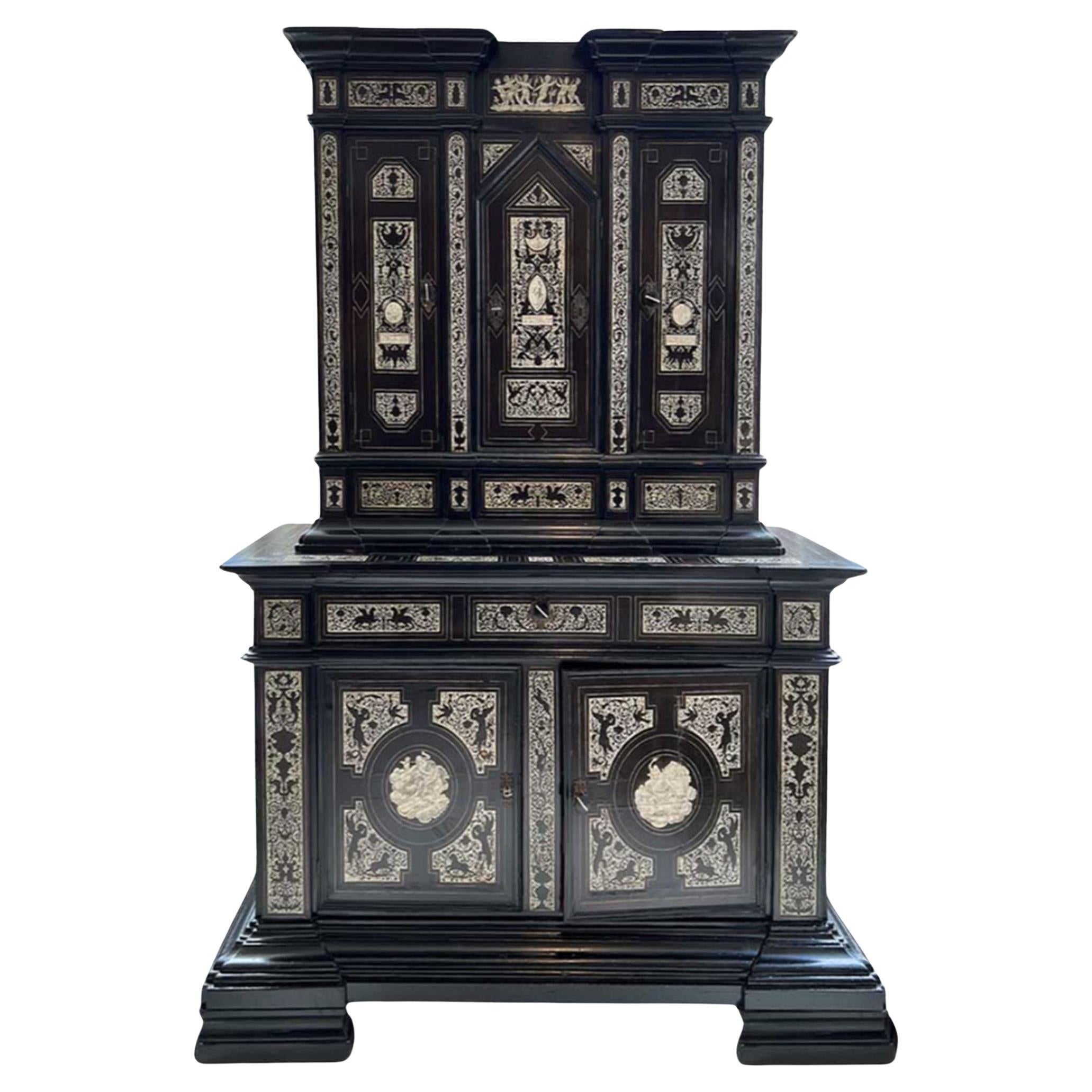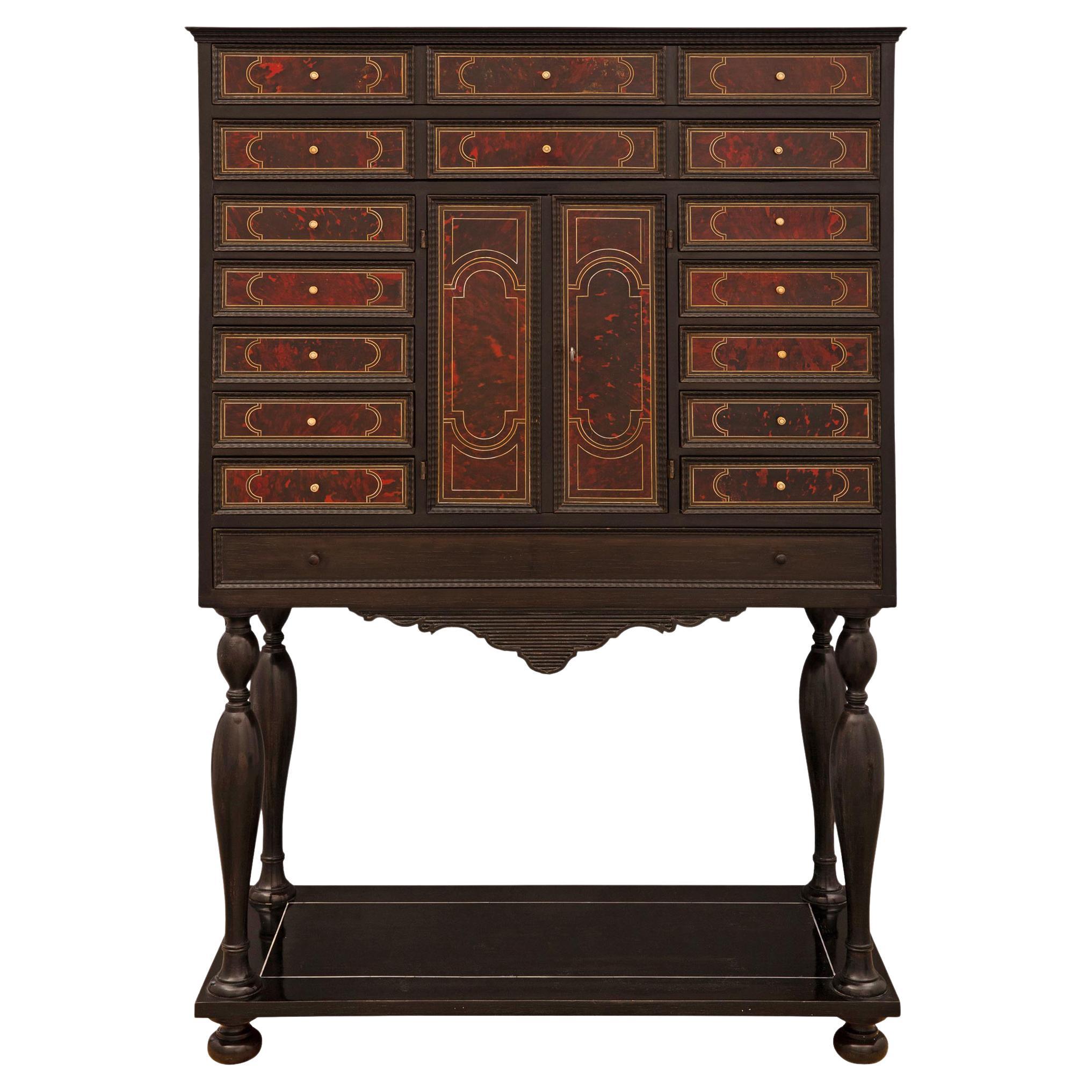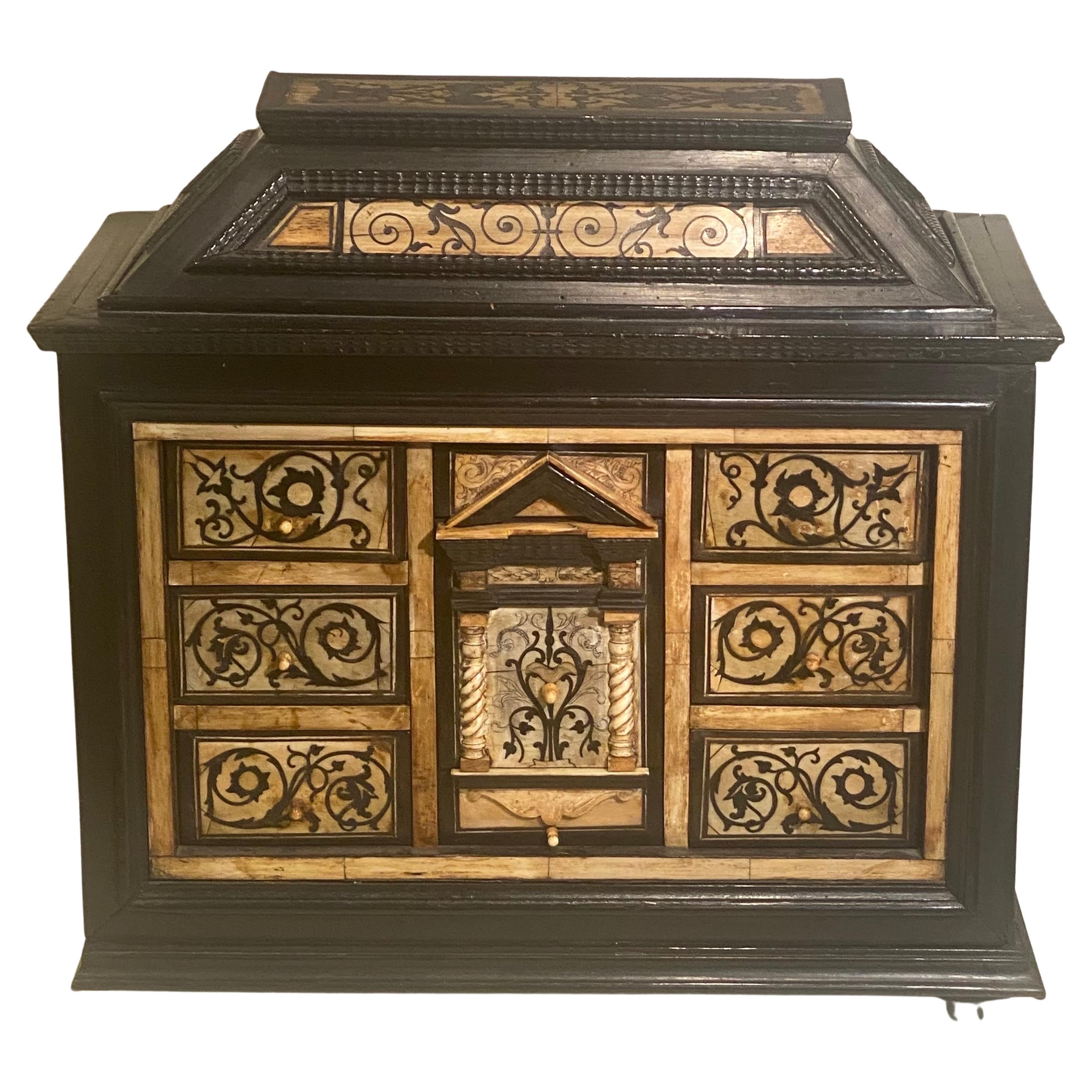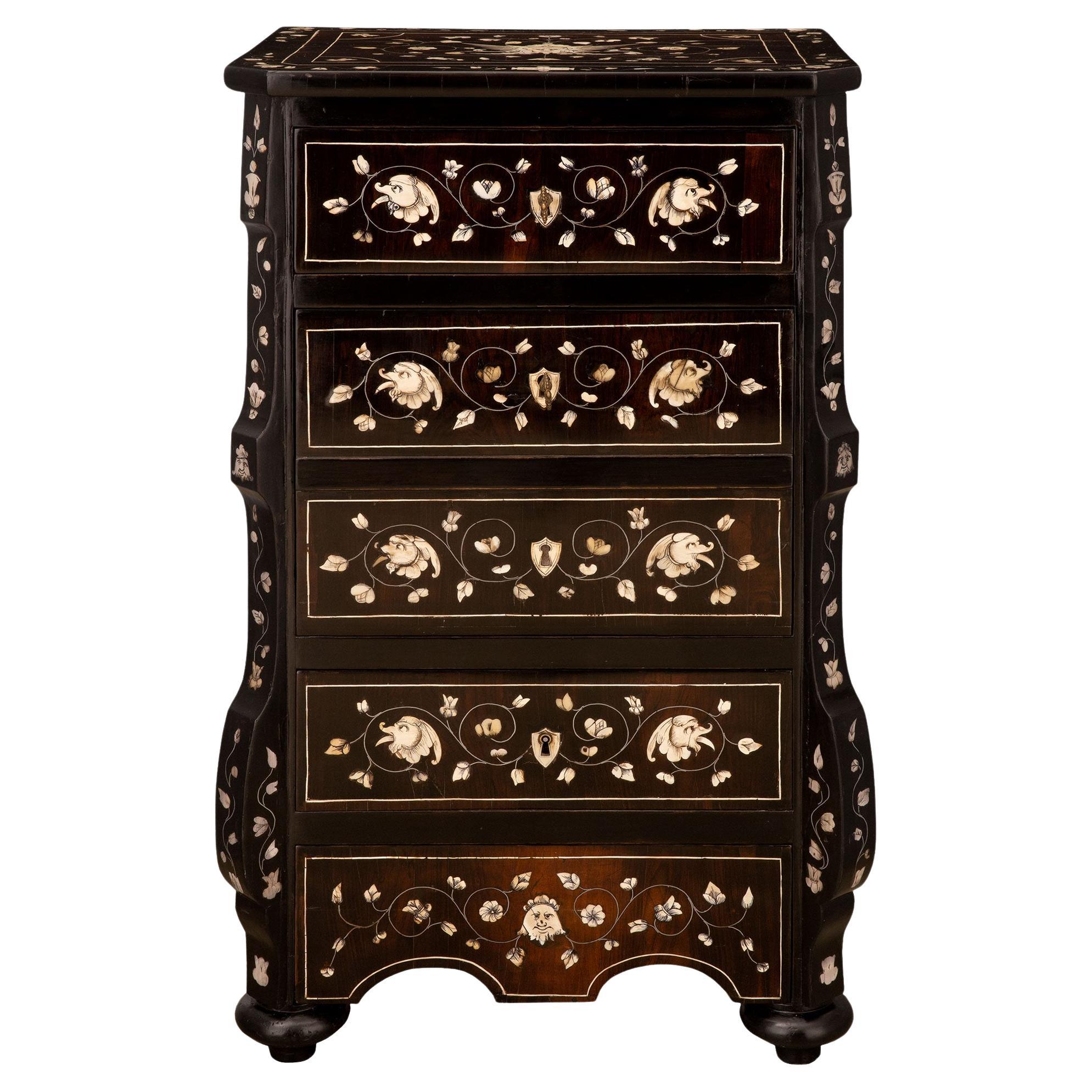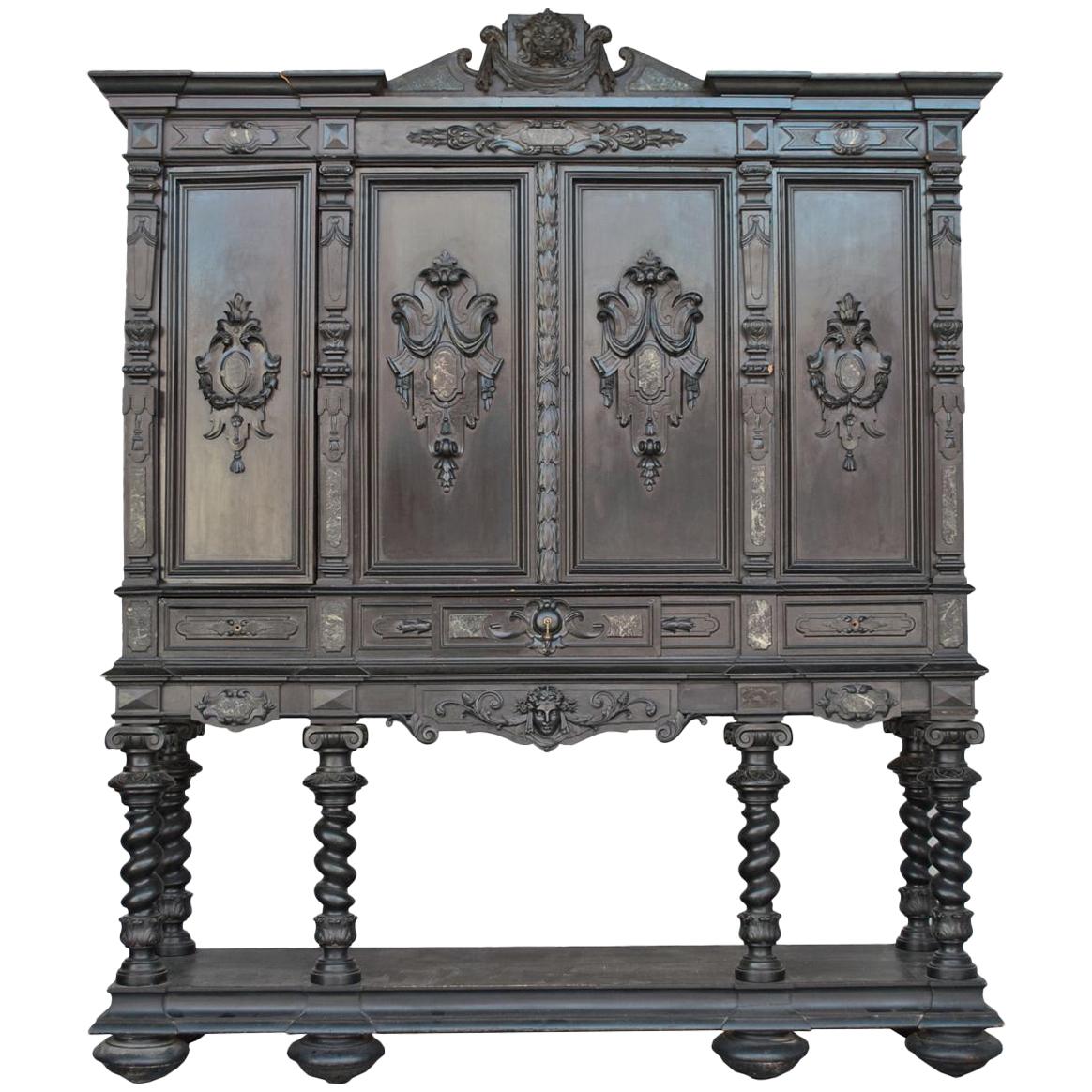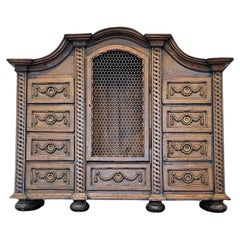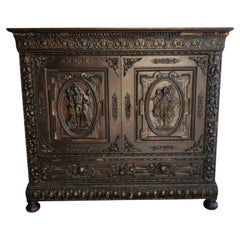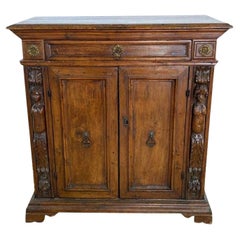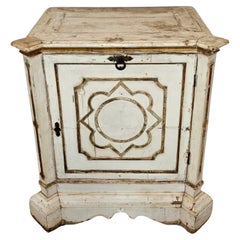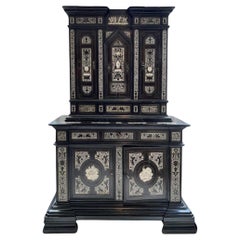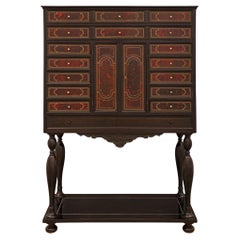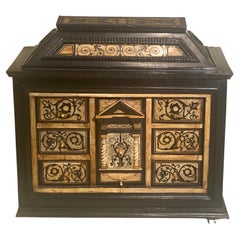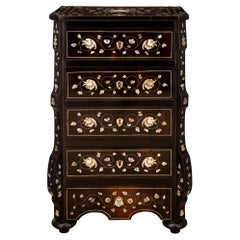Articles similaires à 17th Century Italian Milano Renaissance Period Bone Ivory Ebony Tabletop Cabinet
Vous voulez plus d'images ou de vidéos ?
Demander au vendeur plus d'images ou de vidéos
1 sur 21
17th Century Italian Milano Renaissance Period Bone Ivory Ebony Tabletop Cabinet
8 381,02 €
À propos de cet article
A scarce nearly 400 year old fine quality Italian Lombard ebony rosewood bone and ivory tabletop curiosity cabinet with warm rich beautifully aged patina and interesting provenance. circa 1650
Milan, Lombardy region of Northern Italy, dating to the early to mid 17th century.
Nothing evokes the Renaissance era better than these rare authentic small table cabinets with their refined decorations, extraordinary workmanship, and rare exotic luxurious materials. Precious objects, the cabinet itself has become a jewel, highly prized and shrouded in mystery, they illustrate the epitome of refinement, elegance, and sophistication, showcasing the very finest quality craftsmanship, skilled workmanship, and highly specialized artistic inlay work of the 17th century
Exceptionally executed handcrafted Milanese work, this most precious table cabinet stands out for having such detailed and elaborate engraving work, as well as the exhibition style open-chest rectangular box form, elaborately decorated, featuring visually striking contrasting hand carved and engraved natural bone and ivory filets, marquetry plaques and banding. The dovetailed walnut open-front rectangular case veneered in exotic ebony and rosewood precious woods, fitted with seven drawers including a lower row with three simulated drawer-fronts constituting a single drawer, surrounding a central door opening to reveal niche compartment topped with a pair of small drawers that thanks to an ingenious system allow access to a concealed secret drawer and hidden shelved compartment!
Extensively engraved inlays, stylized scrolling foliate rinceaux arabesque marquetry, blackened ebonized wood trim, affixed with the original ironwork and hardware, including steel ace of spade strap hinges and lock, intricate bronze pierced scrolled openwork spandel corner brackets, and ornate patinated brass lion mask drop-ring pulls, the case with visible dovetail joinery to the top, large framed diamond inlay to the flanks, unfinished verso, all raised on tall turned onion bun feet.
- PROVENANCE / ACQUISITION:
Property from the Collection of Frederick H. Schrader.
Who acquired it from:
Tom Stansbury Antiques, Newport Beach, California;
Acquired from the above owner through the highly reputable auction house Heritage Auctions, Dallas, Texas. 2025 April 17 Sophisticated Palate: Fine & Decorative Arts from the Collection of Frederick H. Schrader, Napa Valley Signature Auction catalog #8210, lot #61046
Fred Schrader is often described as one of the "bad boys" of Napa Valley, a title that reflects his adventurous spirit and unconventional approach to life. In addition to producing many of the world’s finest Cabernet Sauvignons – first with Colgin Cellars, then with Schrader Cellars – Fred Schrader has been an art dealer and collector since the 1970s, and he has traveled the world in pursuit of treasures.
- DIMENSIONS: (approx)
17.5" High, 21.125" Wide, 12" Deep;
(44.5 x 53.7 x 30.5 cm)
- HISTORY:
The cabinet was a furniture replacing the typical two bodies sculpted buffets of the 16th century. It became in the 17th century a pageantry furniture highly appreciated by the greatest sponsors of this period, such as Marie de Medici or the Cardinal Mazarin, that had a collection of more than 20 pieces.
Initially linked to the taste for medals and coins collections of the Renaissance period, the cabinet became itself a object that can be admired thanks to its panels decorated with paintings, precious woods marquetry, ivory, Boulle marquetry, pietra dura, scagliola, etc...
The history of these cabinets is complex and the manufacture was developed in many countries, notably Germany, Holland, Italy, England and France. With the creation of Oriental Indies Companies, occidental models were also built from various elements including lacquer panels and then exported in Europe.
The origin of this type of cabinet is believed to be Dutch. Some craftsmen from the Holy Roman Empire such as Theodore de Voghel and Iacobus Fiamengo were sent to the royal armory of Naples to make rifle and crossbow stocks for the service of the Spanish Habsburgs.
Given the success of this luxurious production, they decided to respond to a growing demand by producing pieces for civilians, in particular precious cabinets for wealthy merchants stopping over in the port.
To do this, they hired "intagliatore d'avoli" such as the engraver Giovanni Battista de Curtis, as well as ironworkers and goldsmiths to create the rich mounts for these travel cabinets.
Several pieces commissioned by the Court and documented are now preserved in Italian museums.
After the revolt of 1647 and the proclamation of the Neapolitan Republic, the production center followed the Spanish court and moved further north to the Duchy of Milan.
Until 1713, the kings of Spain remained Dukes of Milan and made the city one of the richest artistic centers in Europe, developing the arms trade, textiles and especially the banking sector.
In addition to the minting of gold coins, Lombardy became the European capital of finance.
Later, similarly styled cabinets spread through Europe and were enjoyed by royalty, nobility, and wealthy merchants, including the Flemish ceremonial Flemish Antwerp cabinet on stand, German Wunderkammer and Kunstkast Art Cabinet, English scientific collection and specimen cabinet, similar Austrian / South German Augsburg marquetry table cabinet intended for the storage of small rare objects such as exotic shells, geode stones, coral, medals, the very fine gilded bronze ormolu French jewelery casket, petite Indo Portuguese colonial dropfront tabletop chest of drawers, campaign slope, and the very large Morrish inspired Spanish Vargueno traveling writing box desk.
Our example is characteristic of the beginning of this rich luxurious Lombard production, its beautiful state of conservation, delicateness, fine intricacies, and the rare presence of open-case visible drawers with the lack of the typical fall-front panel make this quite the scarcity and a desired object on the market.
**Additional photos available upon request**
- CONDITION REPORT:
A superb museum quality example, in overall fine condition, especially considering its age.
Attractive appearance, with nicely aged warm rich dark patina, original antique character marks and charm throughout. Wear commensurate with age, use and handling, including minor stable splits, surface scuffs, scratches, nicks and abrasions. Some minor age related separation present and a few drawers show typical warping. The interior drawer lining has areas of minor peeling and there is evidence of possible prior repair to a drawer joint. Overall truly remarkable! Delivered lightly cleaned, waxed, ready for immediate use and multi-generational enjoyment!
Guaranteed to elevate any space, it's sure to add refined elegant sophistication, classic rustic warmth, depth, rich antique character and unique historical interest!
- Dimensions:Hauteur : 44,45 cm (17,5 po)Largeur : 53,66 cm (21,125 po)Profondeur : 30,48 cm (12 po)
- Style:Renaissance (De la période)
- Matériaux et techniques:Os,Laiton,Bronze,Ébène,Ivoire,Poirier,Bois de rose,Noyer,Moulage,Ébénisé,Sculpté à la main,Fait main,Incrusté,Menuiserie,Marqueterie,Tourné,Placage
- Lieu d'origine:
- Période:
- Date de fabrication:circa 1650
- État:Usure conforme à l'âge et à l'utilisation. Défauts mineurs. Décoloration mineure. A superb museum quality example, in overall fine condition, especially considering its age. Attractive appearance w/warm rich dark patina/original antique character. Wear commensurate w/ age/use. Please see photos & description for detailed report.
- Adresse du vendeur:Forney, TX
- Numéro de référence:1stDibs : LU5977245433742
À propos du vendeur
4,8
Vendeur Platine
Vendeurs premium dont la note est supérieure à 4,7 et le délai de réponse de 24 heures maximum
Établi en 2013
Vendeur 1stDibs depuis 2021
294 ventes sur 1stDibs
Temps de réponse habituel : <1 heure
- ExpéditionRecherche du devis...Expédition depuis : Forney, TX
- Politique des retours
Certaines parties de cette page ont été traduites automatiquement. 1stDibs ne garantit pas l'exactitude des traductions. L'anglais est la langue par défaut de ce site web.
Garantie d'authenticité
Bien qu'il soit peu probable que la situation se présente, dans le cas où vous rencontreriez un problème d'authenticité d'un article, contactez-nous dans un délai d'un an pour obtenir un remboursement intégral. DétailsGarantie de remboursement
Si votre article n'est pas conforme à la description, est endommagé pendant le transport ou ne vous est pas livré, contactez-nous sous 7 jours pour obtenir un remboursement intégral. DétailsAnnulation sous 24 heures
Vous disposez d'un délai de 24 heures pour annuler votre achat sans motif.Des vendeurs professionnels agréés
Nos vendeurs de renommée mondiale doivent respecter des normes strictes en matière de service et de qualité, afin de préserver l'intégrité de nos fiches produit.Garantie d'alignement des prix
Si vous constatez qu'un autre vendeur a mis en vente le même article à un prix inférieur sur un autre site, nous nous alignerons sur ce prix.Livraison en toute confiance à l'international
Notre réseau de transporteurs de premier ordre propose des options d'expédition spécialisées dans le monde entier, y compris des livraisons personnalisées.Plus d'articles de ce vendeur
Tout afficherCabinet de curiosité à tabernacle en chêne français sculpté du XVIIIe siècle
Cabinet de curiosité à tabernacle en chêne sculpté, de style baroque français rustique, du XVIIIe siècle ou antérieur, présentant une forme architecturale avec une corniche moulurée ...
Catégorie
Antiquités, XVIIIe siècle, Français, Baroque, Meubles de rangement
Matériaux
Laiton
Enfilade néo-renaissance italienne du XIXe siècle du XIXe siècle
Un rare buffet en chêne et cuir de style Renaissance italienne continentale avec une patine chaude et riche.
Né au début du 19ème siècle, d'une fabrication artisanale exquise et ...
Catégorie
Antiquités, Début du XIXe siècle, Européen, Néo-Renaissance, Enfilades
Matériaux
Cuir, Chêne
Meuble de rangement italien du XVIIIe siècle en noyer sculpté
Une rare commode/crédence italienne du 18ème siècle en noyer, période Renaissance, d'influence néoclassique, ayant deux colonnes de statue figurative finement sculptées et décorées d...
Catégorie
Antiquités, XVIIIe siècle, Renaissance, Crédences
Matériaux
Bronze doré
Meuble de rangement italien peint du 19ème siècle à une seule porte
Rare cabinet italien ancien, unique en son genre, peint, marbré et doré, à la patine vieillie. Vers 1830.
Fabriqué à la main en Italie au milieu du 19e siècle, construction en bois ...
Catégorie
Antiquités, Milieu du XIXe siècle, italien, Baroque, Placards
Matériaux
Bois, Pin, Bois doré
Armoire d'angle marquetée en marqueterie baroque italienne du début du XXe siècle
Une armoire d'angle italienne en noyer, corniche moulurée, au-dessus d'un coffret triangulaire, portes d'armoire supérieure et inférieure avec panneaux de marqueterie contrastés, s'o...
Catégorie
Début du 20ème siècle, Baroque, Armoires d'angle
Matériaux
Noyer
Antique Italian Renaissance Era Brass Mounted Walnut Table Cabinet Wall Cupboard
A rare and unusual antique Italian walnut table-top cabinet (now also wall hanging cupboard), 17th century and later elements, with handsome warm rich dark patina and interesting pro...
Catégorie
Antiquités, 17ème siècle, italien, Renaissance, Meubles de rangement
Matériaux
Laiton, Fer
Suggestions
Cabinet italien du 18e siècle avec incrustation d'os
Admirez cette extraordinaire armoire de Fernando Pogliani, de Milan, qui est une fantaisie stratifiée d'ébène et d'os. La façade est ornée d'incrustations complexes représentant des ...
Catégorie
Antiquités, XVIIIe siècle, italien, Meubles de rangement
Matériaux
Os, Bois
Meuble de rangement italien du début du XIXe siècle en ébène, écaille de tortue et spécimen d'os
Une spectaculaire armoire à spécimens italienne du début du 19ème siècle en ébène, écaille de tortue et os. Le meuble à deux portes et vingt-deux tiroirs est surélevé par d'élégants ...
Catégorie
Antiquités, XIXe siècle, italien, Meubles de rangement
Matériaux
Os, Écaille, Ébène
Cabinet de table ancien en ébène et ivoire, fin du XVIIe siècle, Italie du Nord
Ce précieux meuble de table s'ouvre par un couvercle et comporte neuf tiroirs richement décorés de marqueterie d'ivoire et d'ébène représentant des feuillages et des rinceaux. Chaque...
Catégorie
Antiquités, 1670, italien, Meubles de rangement
Matériaux
Ivoire, Ébène
chiffonnier milanais du 19ème siècle en bois de rose, bois fruitier et os
Charmant meuble chiffonnier milanais du XIXe siècle en palissandre, bois de fruitier ébonisé et os, estampillé Brevete VF Paris. Le chiffonnier à trois tiroirs et une porte est surél...
Catégorie
Antiquités, XIXe siècle, italien, Meubles de rangement
Matériaux
Os, Fruitiers, Bois de rose
Important meuble de rangement en bois noirci de style Renaissance du 19ème siècle
Meuble de château : Important meuble en bois noirci de style Renaissance avec colonnes torsadées. Richement sculpté. Décor avec des têtes de femmes et de lions. Travail d'ébéniste fr...
Catégorie
Antiquités, XIXe siècle, Français, Renaissance, Meubles de rangement
Matériaux
Bois
Meuble de rangement de table baroque italien du début du 17ème siècle, en noyer monté de Pietra Paesina
Ce meuble fait partie d'un petit groupe qui a été fabriqué dans les années 1620, lorsque le goût et la mode se sont orientés vers l'utilisation d'une pierre paesina, avec ses veines ...
Catégorie
Antiquités, Début du XVIIe siècle, italien, Baroque, Meubles de rangement
Matériaux
Marbre
